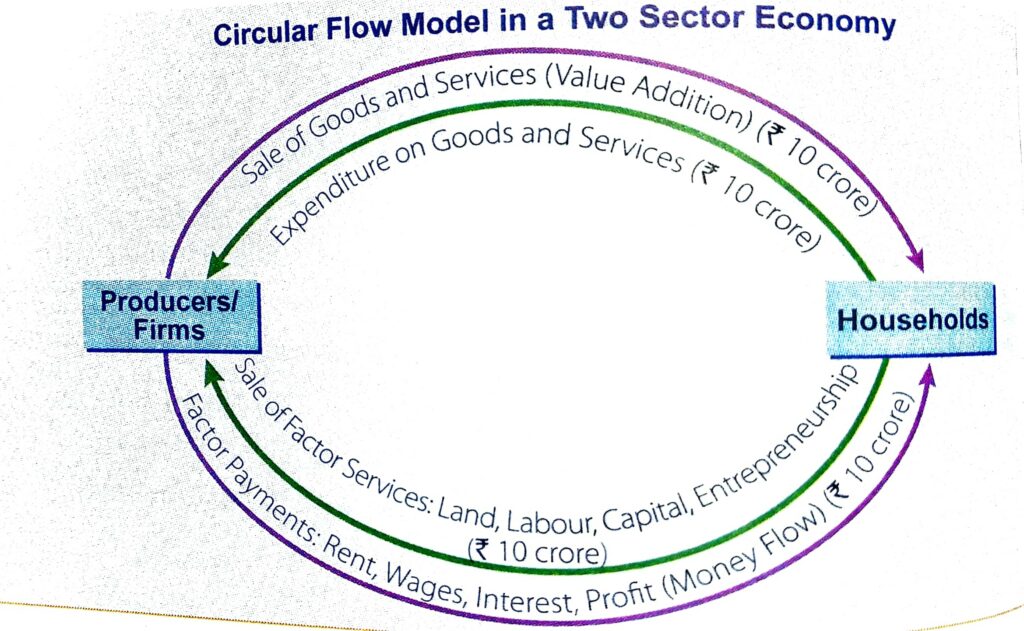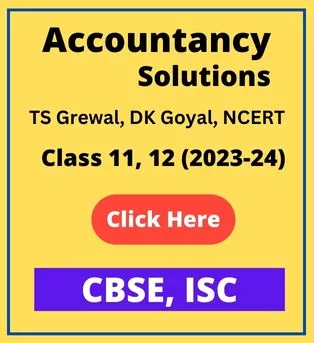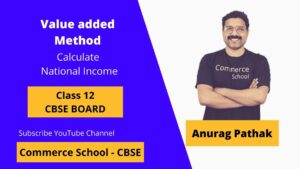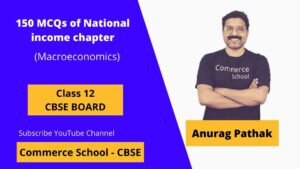
What is circular flow of income in Macroeconomics class 12?
Topic of Circular Flow of Income is concerned with Chapter of National Income macroeconomics class 12 CBSE Board.
A question of MCQ and 3 marks question can come in board exam from this topic.
So, lets understand the basic concept of it.
See, in every economy, three activities never stop
- Production of goods and services
- Generation of income in terms of wages, interest, rent and profit.
- Expenditure in terms of consumption and investment expenditure.
The truth is, these three activities is the life line of an Economy. No economy can exist without these activities.
It is impossible to trace the beginning and end of these activities. Thus the existence of these three activities is assumed as a circle without a beginning or an end.
Note:- All these three activities Production, Income and expenditure are flow variables.
Read Here:- What is stock & flow in macroeconomics class 12
In fact circular flow of income means the circularity of the flows of Production, income and expenditure in any economy.
Definition of Circular flow of Income given in T.R Jain Book
Circular flow of income refers to the unending flow of the activities of production, income generation and expenditure involving different sectors of the economy, the producers and the households in particular. Each activity is the cause as well as the consequence of the other activity. Production in the producing sector generates income for the households who are owners of the factors of production. Expenditure by the households generates demand for further production. Accordingly, production, income generation and expenditure keep chasing each other like three dots continuously moving in a circle.
Book, T.R Jain
Assumptions of the Circular flow of Model
This model is based upon the following assumptions.
- There are only two sector in the economy namely households and producers.
- The households spends their entire income on goods and services thus there are no saving.
- The domestic economy is a closed economy. No exports and Imports at all.
- There is no government in the domestic economy.
Three phases of Circular flow of Income
Circular flow of Income consists of following three phases.
1. Production Phase:-
The production phase simply refers to the value addition. When wood worth ₹ 1000 is converted into the furniture of ₹ 5000. There is the absolute value addition of ₹ 4000.
The production is all about adding value.
In this phase producing sector hires the factors of production (land, labour, capital and entrepreneurship) from households.
The factor inputs add the value to the non factor (raw material) for the production of goods and services.
Production of goods and services are done for the satisfaction of human wants. As there is no end of human wants thus production activities also never end.
In the first phase, income is generated in the production units, But it doesn’t stay in these units. We can label it as the Production Phase.
2. Income Distribution Phase:-
The households get factor payments for rendering their factor services to the producers in the form of
- Rent for land
- Interest for capital
- Wages/salaries for labour
- Profit for entrepreneurship
For household point of view, these are factor incomes.
Production units distribute this income to the factor owners, who are responsible for creating it. Income travels from production units to households.
In this phase value addition (production) is converted into factor income.
3. Expenditure (Dispositon) Phase:-
Income also does not stay with households. They want to acquire goods and services to satisfy personal needs and to create assets to increase income.
When households buy the final goods, there is consumption expenditure. When producers buy the final goods, there is investment expenditure.
from where households buy the goods and services? obviously, from production units. So all income return back to production units itself.
Income is first generated in production units, then distributed by these units to households, and finally spent by households on goods and services produced by these units to make the circular flow complete its course.
Thus there is a non-stop flow of production of goods and services, generation of income and disposition of income. Each flow keeps chasing the other flow. Which is why it is called circular flow.
In sector economy:-
Production (the value of goods and services) = Income generated = Expenditure
This is called triple identity. It is illustrated in below flow model.

Further Reading:-
| S.N | Topics |
| 1. | What is GDP Deflator |
| 2. | What are externalities in economics |
| 3. | Limitations of GDP as a measure of welfare |
| S.N | Topics |
| 1. | 150+ Numerical of Value Added Method |
| 2. | 150+ Numerical of Income Method |
| 3. | 150+ Numerical of Expenditure Method |
| 4. | 150+ Numerical of National Income and related aggregates |
| S.N | Topics |
| 1. | 250+ MCQs of National Income |





